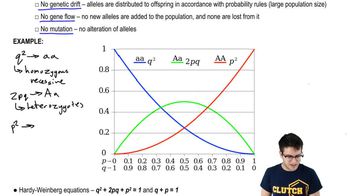22. Evolution of Populations
The Hardy-Weinberg Principle
22. Evolution of Populations
The Hardy-Weinberg Principle
Additional 2 creators.
Learn with other creators
Showing 5 of 5 videos
Practice this topic
- Multiple ChoiceIn the context of populations, how do we define evolution?
- Multiple ChoiceAllele frequencies can be altered by __________.
- Multiple ChoiceIn the Hardy-Weinberg equation, p2 represents __________.
- Multiple ChoiceIn a large population of bonobos, the frequency of the recessive allele is initially 0.1. There is no migration and no selection. What is the frequency of the dominant allele? Assume that there are two alleles of this gene.
- Open QuestionWhat are the four nitrogenous bases found in RNA?a. cytosine, guanine, thymine, uracil (C, G, T, U)b. adenine, cytosine, guanine, thymine (A, C, G, T)c. adenine, cytosine, guanine, uracil (A, C, G, U)d. alanine, cysteine, glycine, threonine (A, C, G, T)
- Open QuestionIn what sense is the Hardy–Weinberg principle a null hypothesis?
- Open QuestionIf the nucleotide variability of a locus equals 0%, what is the gene variability and number of alleles at that locus?a. genevariability=0%;numberofalleles=0b. genevariability=0%;numberofalleles=1c. genevariability=0%;numberofalleles=2d. genevariability>0%;numberofalleles=2
- Open QuestionThere are 25 individuals in population 1, all with genotype AA, and there are 40 individuals in population 2, all with genotype aa. Assume that these populations are located far from each other and that their environmental conditions are very similar. Based on the information given here, the observed genetic variation most likely resulted froma. genetic drift.b. gene flow.c.nonrandom mating.d. directional selection.






